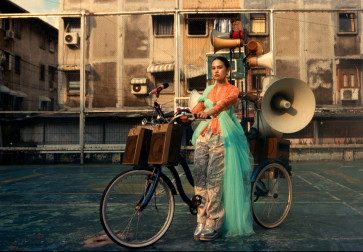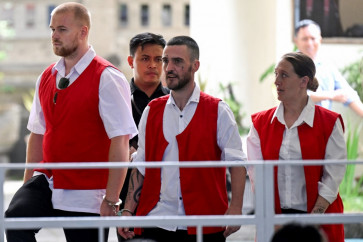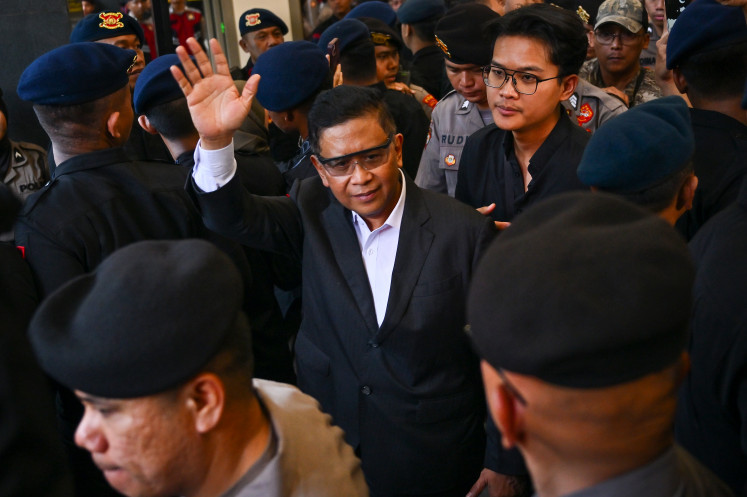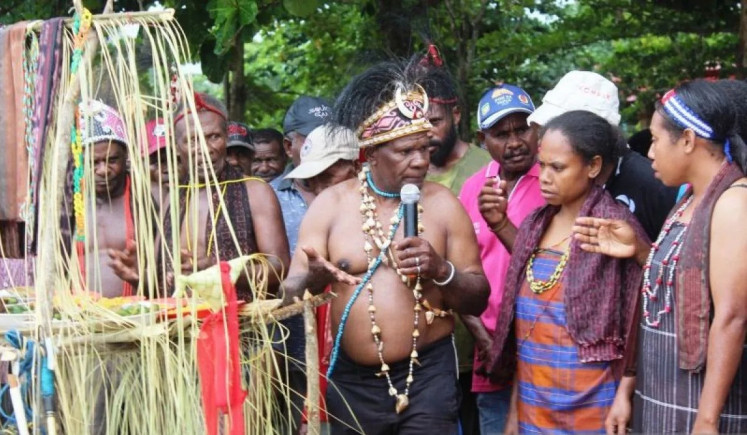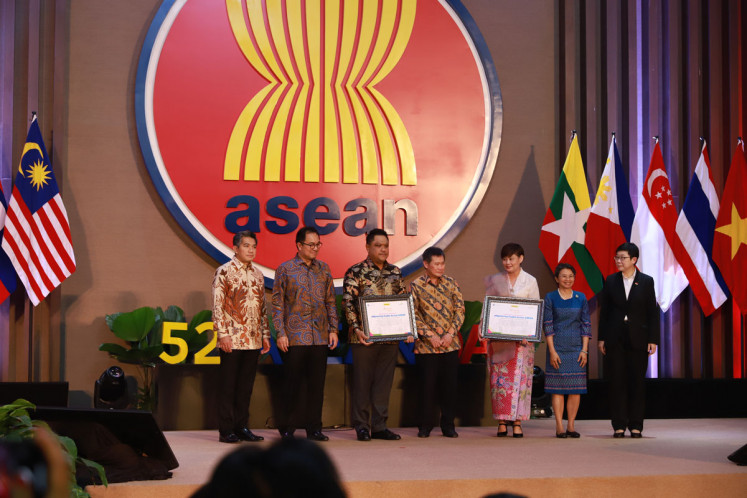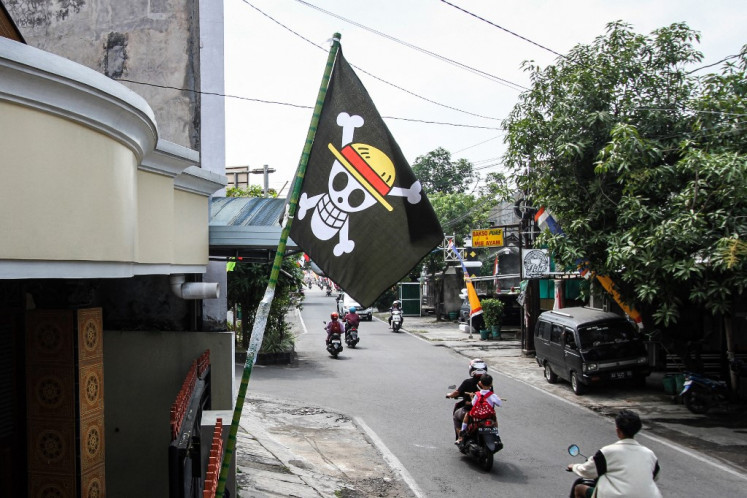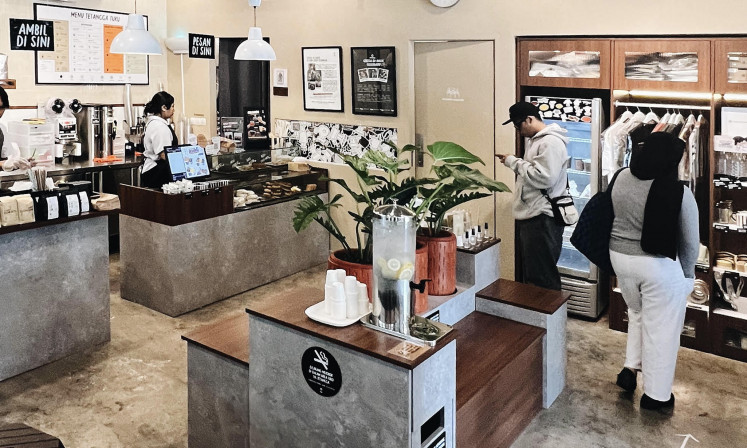Popular Reads
Top Results
Can't find what you're looking for?
View all search resultsPopular Reads
Top Results
Can't find what you're looking for?
View all search resultsWe need all hands on deck to make industrial decarbonization happen
Green energy subsidies, expanding tax incentives for green technologies, price control mechanisms like contracts for difference and more coordinated financial assistance will ease the burden of industrial decarbonization projects.
Change text size
Gift Premium Articles
to Anyone
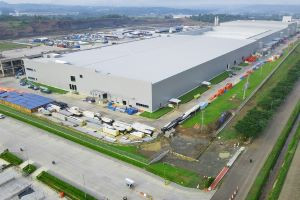 The newly completed facilities of PT HLI Green Power, the first electric vehicle battery factory in Southeast Asia, is seen in this undated photo released by Karawang New Industry City (KNIC). Located in the KNIC industrial estate in Karawang, West Java, HLI Green Power is a joint venture company between Korea’s Hyundai Motor Group and LG Energy Solution, and is slated to start production next year. (Karawang New Industry City)
The newly completed facilities of PT HLI Green Power, the first electric vehicle battery factory in Southeast Asia, is seen in this undated photo released by Karawang New Industry City (KNIC). Located in the KNIC industrial estate in Karawang, West Java, HLI Green Power is a joint venture company between Korea’s Hyundai Motor Group and LG Energy Solution, and is slated to start production next year. (Karawang New Industry City)
T
he Indonesian proverb Berat sama dipikul, ringan sama dijinjing reminds us even the heaviest burden, like decarbonizing our industries, can be made manageable if we carry it together.
While the European Union enacted its first climate policy 50 years ago, and countries like China began cutting emissions two decades ago, Indonesia is now building its footing and accelerating progress. Encouragingly, this momentum comes at a time when we need it most.
As one of the most climate-vulnerable countries in the world, ranked third globally by the Asian Development Bank, Indonesia can no longer afford to delay. The consequences of climate change are already felt and the worst is yet to come.
Droughts are threatening harvests in Java, floods are disrupting lives and livelihoods in Kalimantan and rising sea levels are putting pressure on coastal cities like Jakarta. For too long, our response has not matched the urgency. But that is beginning to change.
Industrial decarbonization is becoming a critical focus because the sector is one of our highest-emitting and hardest-to-abate, yet holds major potential for climate impact and green investment. The Industry Ministry has set a clear and science-aligned target for the industrial sector to achieve net-zero emissions by 2050.
The greenest National Electricity Supply Business Plan (RUPTL) of state power producer PLN to date has been issued, committing to the development of 42.1 gigawatts of renewable energy and 10.3 GW of storage by 2034, signaling a long-term shift toward cleaner and more reliable power for Indonesia’s economy. Meanwhile, industries are adopting energy efficiency measures and exploring fuel-switching from coal to lower-carbon alternatives.
In parallel, the government is rolling out enabling policies. The Financial Services Authority (OJK) has launched a green taxonomy to guide financial institutions in navigating green investments.
The foundation has been laid and the path forward is becoming clearer. What is needed now is an all hands-on deck decarbonization effort involving government, industry, financiers and offtakers to turn momentum into real and sustained change.
So, what will it take to accelerate industrial decarbonization in the country?
The answer lies in understanding what industries need. When asked, their concerns are strikingly consistent: 1) Clean energy and sustainable raw materials are either too expensive or in short supply. 2) There are no mandatory emission reduction targets, and few incentives to meet them. 3) Even when low-carbon products are produced, they are more costly, and without strong market signals, who will buy them?
To enable a low-carbon and competitive industries, a comprehensive policy framework is designed to address all three key stages of production and consumption cycle: pre-production (upstream), production (downstream) and post-production (market).
In the pre-production stage, the goal is to provide clean energy and sustainable raw material supply. This means investing in infrastructure (e.g., hydrogen supply chain, biomass pre-treatment industry, advanced electricity grid) and enforcing standards with minimum trade-offs. These resources must also be competitively priced.
In the production stage, the goal is to decarbonize industrial processes. This requires clear emission targets and efforts to derisk investment in new technologies through stronger incentives, such as carbon pricing or regulations linking emission performance to permits.
In the post-production stage, the goal is to build strong demand for low-carbon products. Without market readiness, even the greenest production efforts fall short. Short-term subsidies for low carbon products can help level the playing field.
Green standards, particularly through green public procurement, are essential to normalize and commercialize low-carbon goods. In the long term, public procurement policies and trade alignments, such as “mini-lateral climate/trade clubs”, can reward green goods.
The real question: how far (or close) are we to our net-zero targets?
Signs of progress are emerging.
PLN’s latest RUPTL targets 60 percent of new electricity capacity by 2050 from renewables, reducing grid emissions and benefiting industries seeking lower-carbon footprints. It reflects growing confidence in renewable infrastructure.
Green power procurement is improving. Since launching Renewable Energy Certificates (REC) in 2020, PLN now offers a dedicated-source option, allowing industries to select specific renewable plants under the Green Energy as a Service (GEAS) umbrella.
The Ministry of Industry is developing a decarbonization roadmap for nine priority sectors, including cement, metal, fertilizer, textile, pulp and paper, chemical, ceramic and glass, as well as food and beverages. This roadmap outlines emissions targets, required technologies and needed investments, providing industries with clear policy signals.
To support evidence-based policies, the Environment Ministry recently required industrial companies to submit emissions data through the National Industry Information System (SIINas). This is a key step toward good governance and the national emission trading system, which is currently in development. Carbon pricing is planned to start in 2027 for cement, iron and steel, fertilizer and pulp and paper industries.
Still, challenges remain. WRI Indonesia’s ongoing research projects that the Levelized Cost of Product (LCOP) of green products may increase 29 to 81 percent, mainly due to high green energy and transition costs.
Future policies can ease this burden: green energy subsidies, expanding tax incentives for green technologies, price control mechanisms like contracts for difference and more coordinated financial assistance will ease the burden of industrial decarbonization projects.
Building market and consumer awareness is also essential. Green product standards, whether government-initiated and backed (e.g. Green Industry Standard, Eco-Label) or voluntary (e.g. Greenship, FSC), help consumers identify sustainable choices. The next step is formulating Green Product Procurement (GPP) mechanisms to boost product absorption, using the existing regulation as a go-to market avenue.
However, strengthening domestic action is not enough.
As part of the global supply chain, Indonesia’s industrial transformation depends on international market signals. Global buyers must prioritize green products from emerging economies.
Integrating green market access into trade agreements and bilateral dialogues is crucial. A strong domestic and international green market will give industries the confidence and economic rationale to decarbonize.
Indonesia’s journey in decarbonizing the industries may be in its early stages, but momentum is building. Roadmaps are in place. Policies are emerging. Industries are starting to act.
Still, industrial decarbonization remains one of the most complex challenges of our time. Cost, market, and policy barriers cannot be solved by the government alone. They require collective action across the entire value chain.
As the aforementioned proverb reminds us, even the heaviest burden becomes lighter when carried together.
What is needed now is not just commitment but coordinated action. Only through unified and strategic effort can today’s progress become a lasting transformation of a competitive green industry ecosystem, benefitting people and planet.
***
Nada Zuhaira is net zero research analyst, Arif Utomo is senior lead engagement, energy and sustainable business and Clorinda Wibowo is senior manager of energy and sustainable business at WRI Indonesia.


